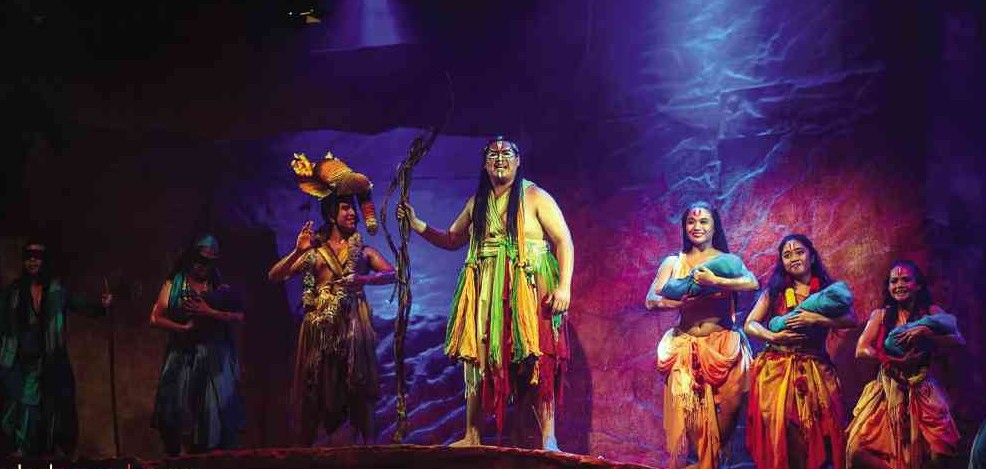
Seasoned playwright Floy Quintos attempts to capture through the musical play “Ang Nawalang Kapatid,” the inherent complexity, cultural and religious specificity, and the folkloric, visionary wisdom found in the Indian epic “Mahabharata.”
Originally written for Ateneo Children’s Theater in 2010, the play is the closing production of Dulaang UP’s 38th theater season.
The re-imagining of this epic for a small hall like Wilfrido Ma. Guerrero Theater surprisingly reveals what drama really entails—the collaborative creation of a provisional world, with all artistic decisions devised to legitimize the perception of these simulacra of gestures and energies.
Quintos has an acute understanding of the underpinnings of the original narrative chart that holds together the “Mahabharata.” This makes his option to anchor the adaptation on Karna (the banished brother of the Pandava princes) a matter of recognition of a more pragmatic and artistic vantage point as far as true dramaturgy is concerned, and not a tendentious and capricious authority imposed upon an already interesting and rich material.
Heaven-and-hell logic
The centrality of Karna in the play, given the archetypal trappings of his background, would have been read as a too easy preservation of the one-dimensional Western religious hero, glossing over Karna’s link to Arjuna as the latter’s dark Other or the multi-layered world view of Hinduism, and in the process cursorily leaving out the gray areas that exist peripherally to the heaven-and-hell logic of salvation history.
The play, though, maintains a solid discernment of the necessary dialectic involving dharma and adharma, revealing the frail humanity of the characters against the inevitable cathartic force of the cleansing sacrifice that goes beyond good and evil.
Dexter Santos’ direction and choreography is a heady mixture of electrifying physicality, dynamic poetry, and practical intelligence. His aesthetic vision translates well even within the constraints of a small stage.
He never shortchanges the audience with extraneous or second-rate dance numbers, routines, tableaux and whatnot. Dance becomes a key ritualistic and primal transmutation of the inexpressible into what is provisionally perceptible.
This lucid combination of the physical and the mental in his work is reflective of his comprehension of the involutional interweave of the same dimensions in that consequential battle between the Pandavas and the Kauravas.
Ceejay Javier’s music and Louise Ybañez’s arrangement offer functional support to the emotional texture and narrative arc of the story. A lot of the songs are hummable and may even survive outside of the play.
The ever-reliable concept of the “hook” takes over, as in most classic commercial successes we’ve witnessed within the world of popular music, but without much musical intricacy.
Too much complexity can be irritating and pretentious, particularly in cases where it is not earned. Javier’s music achieves an unbelievable poignancy if heard within the context of the drama. That bolt from the blue will surely come and anyone who values sincerity will feel it from the gut.
Not lackluster
The singing is sometimes weighed down by technical problems, but at least it is not lackluster. Jon Abella and Vincent Kevin Pajara are both exceptional as Yudisthira and Duryodhana, respectively.
Teetin Villanueva’s Draupadi is strong, both vocally and dramatically. Ross Pesigan can be endearing as Karna but sometimes loses conviction.
The all-student cast works up a riveting ensemble performance that surpasses even the best of its actors’ histrionics considered individually.
The two most memorable sections of “Ang Nawalang Kapatid” strategically frame the exile, which in its religious context represents the diksa or preparation that precedes the cleansing sacrifice.
The famous dicing match that comes after the rajasuya turns into a harrowing game of desire. There is a frighteningly dark energy that characterizes the buildup of the entire scene.
The frenetic progress of the war section is unnerving, and, at least in my own experience, a most gut-wrenching tableau of death, with the ensemble whirling a ruinous danse macabre.
The silence after the war becomes a haunting scenario: The two mothers, Ghandari and Kunti, enter and sing “Doon sa Paroroonan,” a delicate lullaby with a beautiful melody and spare, tinsel-thin accompaniment.
The flaws of this production are certainly not enough to make you want to stay away from it. There are plays with technically polished façades that will never profoundly move you.
The revelations in this work’s initial mythopoeic preoccupations are founded on primeval discoveries that resonate among communities of theater-goers. What makes for arresting theater transcends the affect-effect nexus.
Dulaang UP’s production of Floy Quintos’ “Ang Nawalang Kapatid” runs March 14, 7 p.m.; and March 15, 3 and 8 p.m. Call 9261349, 4337840, 0917-8239531, 0927-7406124.















































